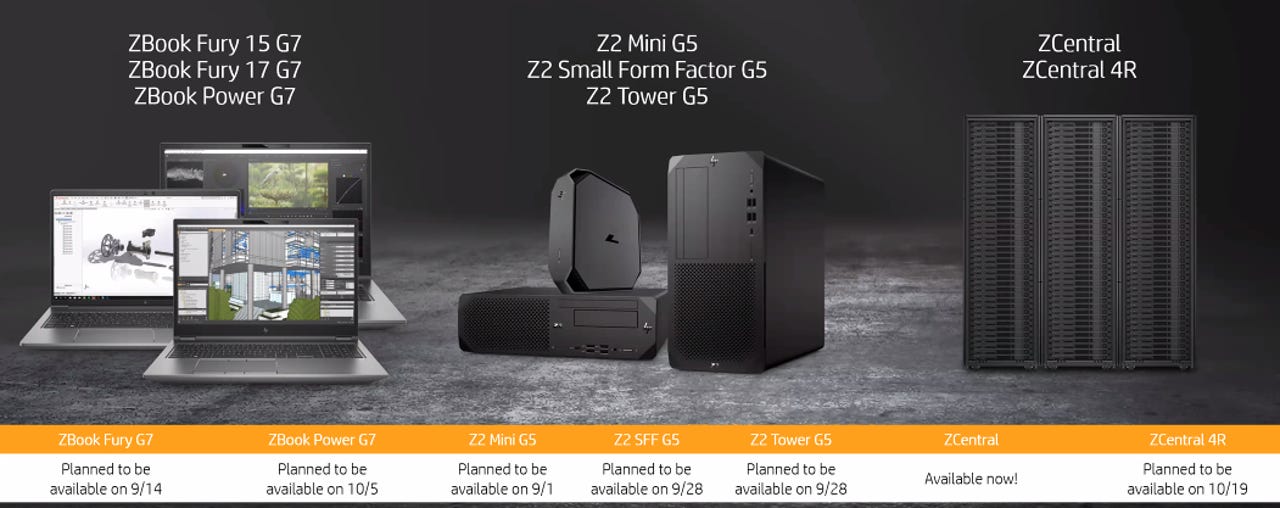HP launches new Z workstations and ZCentral virtual desktop system

HP is rolling out a series of Z workstations as well as an updated ZCentral virtual desktop platform to bolster the move to remote work for creative pros, medical professionals, and data scientists.
As enterprises moved to remote work amid the COVID-19 pandemic, demand for laptops, desktops, and workstations for home surged. The boom in demand was reflected in the second-quarter results from both HP and Dell Technologies.
However, Jim Nottingham, general manager of Z by HP, said it has become clear that the "PC has a new role and is essential." These devices are going to be more essential since HP has found that "80% of creators and power users want to work from home full or part-time."
Nottingham said more power is needed at the edge of remote work for tasks like editing video, architectural design, reading medical images, and crunching algorithms in the background as you read email.
The Z portfolio will be preloaded with data science tools such as Ubuntu 20.04 Linux, deep learning and machine learning libraries, and Python & R Studio.
HP's refresh includes three portable workstations:
- ZBook Fury 15 G7
- ZBook Fury 17 G7
- ZBook Power G7
Three desktops:
- Z2 Mini G5
- Z2 Small Form Factor G5
- Z2 Tower G5
And ZCentral and ZCentral 4R, which are virtual desktop systems.
These systems will be available throughout September and October.
Of the systems, the one that may have the most enterprise punch is the ZCentral 4R, a 1U rack workstation that has Intel Xeon W Processors up to 18 CPU cores, Nvidia Quadro RTX 8000, and an optional redundant or aggregated power supply. The ZCentral 4R is for enterprises looking to deliver compute power to remote workers virtually via software that sends and receives computing across multiple operating systems.
Companies such as VMware and Citrix are both seeing gains as enterprises use virtual desktops to keep workers remote and secure.
HP's other move is to bring desktops typically found in the office to remote workers. The Z2 Mini G5, Z2 Small Form Factor G5, and Z2 Tower G5 revolve around the idea that remote workers can't be on laptops all the time due to the need for computing power and connecting to keyboards and monitors with a small footprint.
Anu Herranen, director of new product introduction advanced compute and solutions for Z by HP, said "the personal PC and notebooks are not sustainable." "You need a PC and higher-end system. It's a new life for the desktop," she said.
As for the ZBook lineup, HP focused on more compute, memory, and storage in a smaller footprint. For instance, the Fury 17 G7 has anywhere from 30% to 70% more performance over its previous generation. The ZBook Fury 15 G7 is 12% smaller.
Key points:
- HP Z2 Mini G5 will run on 10th Generation Intel Core processors (Core i3 to Core i9; Intel Xeon W various); 64 GB DDR4-3200 ECC SDRAM (and non-ECC SDRAM) maximum memory; 256GB to 2TB internal storage with various configurations; Nvidia Quadro, AMD Radeon Pro for graphics (various configurations).
- HP Z2 Small Form Factor G5 Workstation will have same processors, internal storage ranges, graphics processors and 128GB maximum memory.
- HP Z2 Tower G5 has similar processors, internal storage, graphics processors and maximum memory as the Z2 Small Form Factor G5 Workstation.
- HP ZBook Fury 15 G5 has latest Intel CPUs and Nvidia Quadro RTX 4000 or 500 GPUs. Up to 128GB of RAM, wide range of storage options with connections up to 10 TB local PCIel NVMe storage. Dual Thunderbolt ports. The ZBook Fury 17 G7 has AMD Radeon Pro W5500M and Radeon RX 5500M GPU options.
